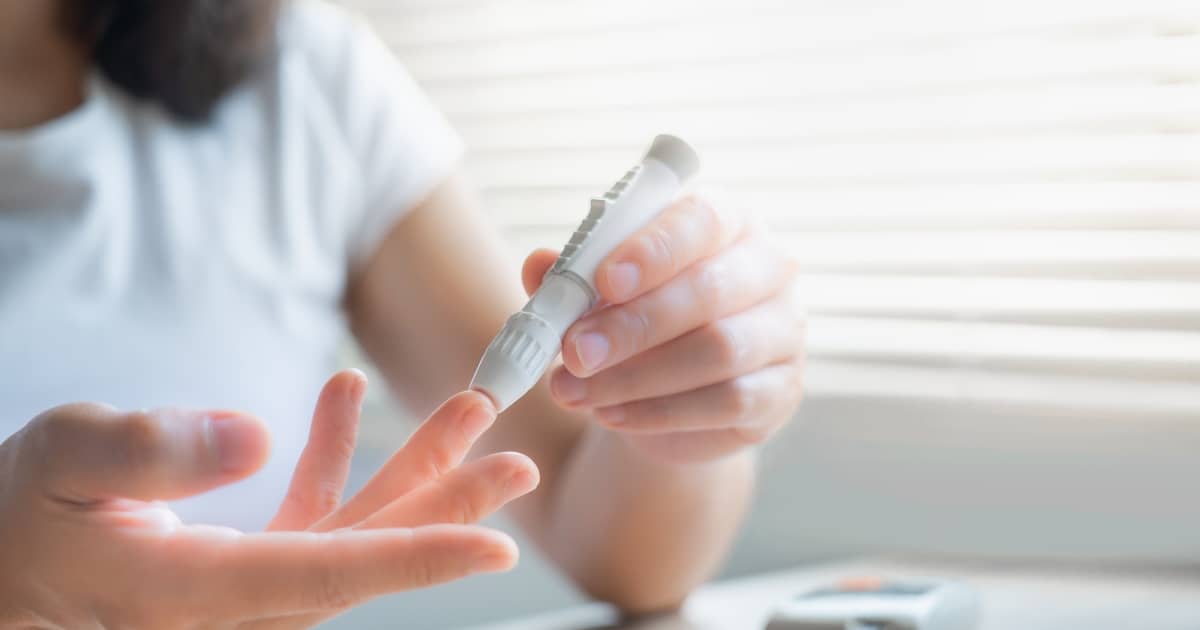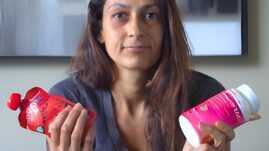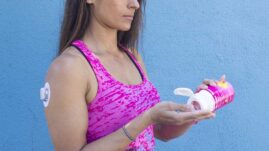Struggling with both high and low blood sugars is pretty much an expected part of living with diabetes.
But reactive hypoglycemia is different from regular low blood sugar levels that people with diabetes encounter, as it has different underlying causes.
This article will tell you everything you need to know about reactive hypoglycemia: what it is, how to manage it, and how to better prevent it.

Symptoms of low blood sugar
It’s important to recognize the symptoms of low blood sugar before it becomes an emergency.
Low blood sugar is usually defined as any blood sugar level under 70 mg/dL. Even people without diabetes can experience low blood sugar!
The signs to look out for include:
- Shakines
- Dizziness
- Anxiety
- Difficulty concentrating
- Sweating
- Confusion
- Rapid heartbeat
- Weakness and extreme fatigue
- Feeling faint
- Hunger
- In severe cases, loss of consciousness, coma, and death
If you’re suffering from frequent low blood sugar levels and you do not have diabetes, you should talk to your doctor.
What is reactive hypoglycemia?
Reactive hypoglycemia (also called postprandial hypoglycemia) is a type of low blood sugar that occurs after meals, typically between 2-5 hours after you finish eating.
This is different from a fasting low blood sugar, as the cause is the release of too much insulin for the food that was eaten.
There are three different types of reactive hypoglycemia:
Alimentary reactive hypoglycemia – This is the form of reactive hypoglycemia that occurs around 2 hours after finishing a meal.
Idiopathic reactive hypoglycemia – This is the form of reactive hypoglycemia that occurs around 3 hours after finishing a meal.
Late reactive hypoglycemia – This form of reactive hypoglycemia occurs between 4 to 5 hours after finishing a meal.
What are the causes of reactive hypoglycemia?
Researchers are unclear on the exact causes of reactive hypoglycemia. However, people who often suffer from reactive hypoglycemia typically are either prediabetic or have diabetes and suffer from gastrointestinal dysfunction, such as gastroparesis.
Additionally, people who do not have diabetes but have a hormone deficiency sometimes also have reactive hypoglycemia.
Reactive hypoglycemia can also be caused by a cancerous tumor, excessive alcohol intake, or when recovering from surgeries, especially gastric bypass or ulcerative surgery.
Reactive hypoglycemia typically occurs more often in people who are overweight and obese. In fact, suffering from reactive hypoglycemia, especially late reactive hypoglycemia, may put you at higher risk for developing diabetes.
How do I manage reactive hypoglycemia?
If you suspect that you have reactive hypoglycemia and you do not have diabetes, ask your doctor about getting a mixed-meal tolerance test, or MMTT.
This is where they will give you a sweet drink made to raise blood sugar levels, causing your body to produce more insulin. The doctor will then closely track your blood sugar over the next several hours, to see if you have a spike and then a crash.
Dropping too low (under 70 mg/dL) several hours after drinking the liquid could be a sign that you’re suffering from reactive hypoglycemia.
If you currently have insulin-dependent diabetes, you may want to talk to your doctor about lowering your insulin-to-carbohydrate ratio or taking less long-acting insulin, or maybe both.
If you are suffering from low blood sugars after meals, have diabetes, but are not on insulin, talk to your doctor about potentially lowering your diabetes medications.
However, if you’ve tried all of that and are still unsuccessful in treatment, below are some strategies to implement to help manage reactive hypoglycemia.
It’s important to note that there is no clinical “cure” for reactive hypoglycemia, but just ways to blunt the pancreas’ response to food that can help prevent such low blood sugars after meals.
First, treat the low blood sugar
Remedying reactive hypoglycemia in general is different from treating an acute episode of low blood sugar.
Eat at least 15 grams of fast-acting carbohydrates, such as glucose tablets, juice, or something else sweet like candy, and test your blood sugar again to make sure it’s rising.
If you are dangerously low and your blood sugar is not responding to fast-acting glucose, call 911 immediately and have someone give you glucagon.
Eat smaller, more consistent meals
Try making sure to eat a meal or snack every 2-3 hours, so you’re never starved. When you do eat, make sure it’s not a huge meal and a huge carbohydrate dump. This will help prevent your pancreas from releasing too much insulin, resulting in low blood sugar.
Not eating all day long, and then eating a huge meal at suppertime can increase the bouts of reactive hypoglycemia, sending your blood sugar plummeting right as you’re getting ready for sleep.
Focus on fat and protein
When you do eat a meal or snack, make sure it’s packed with protein and healthy fats, rather than simple carbohydrates.
Meals and snacks with lots of processed and added sugars and carbohydrates require more insulin and are more likely to result in reactive hypoglycemic episodes.
Healthy proteins and fats include foods like salmon, full-fat dairy products like Greek yogurt, peanut butter, seeds and nuts, extra virgin olive oil, coconut, avocado, and lean meat.
You can easily build a meal around these food items, by adding leafy greens and colorful vegetables that won’t cause a blood sugar and insulin spike.
If you drink alcohol, don’t do so on an empty stomach
If you’re susceptible to low blood sugar levels and reactive hypoglycemia and you enjoy drinking alcohol, always drink it with food.
Alcohol lowers blood sugar levels, and if you haven’t had anything to eat for several hours, it can put people with diabetes (even those without!) at risk for low blood sugar levels.
Better yet, pairing alcohol with a higher-fat, high-protein snack can ensure smoother blood sugar levels all evening long. Think cheese, olives, and raw vegetables with hummus alongside that glass of wine.
Exercise regularly
It’s important to get regular exercise to help maintain consistent blood sugar levels throughout the day. Aim to exercise in the early morning or afternoon, when insulin resistance is at its highest (and you’re the least likely to go low).
If you struggle with reactive hypoglycemia after dinnertime, that is not the best time to exercise. However, establishing an exercise routine at the same time every day will help your body learn how to respond to both carbohydrates and physical activity better, thus reducing the likelihood of severe low blood sugar levels.
If you don’t know where to start, talk with your doctor about developing an exercise routine that will work for you and your lifestyle.
Conclusion
Reactive hypoglycemia is a form of low blood sugar that happens after meals.
People both with and without diabetes can suffer from this condition, but it is more common in people who are overweight or obese, are prediabetic, have diabetes and a gastrointestinal problem, such as gastroparesis, and people who are recovering from surgery, are struggling with alcohol addiction, or have cancerous tumors or a hormonal imbalance.
There are a few ways to manage reactive hypoglycemia: the first, if you have diabetes, is by lowering your diabetes medications and/or insulin. Talk with your doctor about how you can safely do this.
Always treat low blood sugar levels under 70 mg/dL immediately and call 911 if you’re experiencing a severe low blood sugar that’s not responding to treatment.
In the longer term, you may opt to eat smaller, more consistent meals focused on healthy fats and proteins, exercise regularly in the morning, and only drink alcohol with food.
By taking these strategic steps, you can help manage reactive hypoglycemia and prevent it from taking over your day.




Yvonne
I have hypoglycemia I do not have diabetes. I don’t have a reactive hypoglycemia. I do have autoimmune diseases, but they are IBD HLAB27. Hashimoto’s thyroiditis. But nothing I have found that was listed that would make me prone towards hypoglycemia. I have been played with this for years and cannot figure out what the problem is. This is causing migraines and it’s driving me crazy.
M Holland
Very informative! I’ve had type 1 diabetes since I was 10 yrs old (51 years). Since my digestive system has become more inflamed (usually due to which foods I eat or stress!) and gastroparesis occurs occasionally, I experience hypoglycemia AFTER eating more than in the past. Thank you for providing this helpful information.
Reg Munro
This looks like an issue that CGM would help both diagnose and manage. Has any research been done on the bg patterns that would indicate reactive hypos?
I have a similar interest in whether CGM patterns might help diagnosis of Gastroparesis?
Christel Oerum
It’s not somehing I’ve researched extensively. But definitely an interesting topic